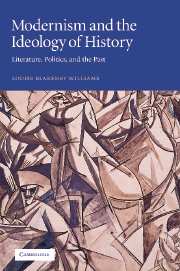Book contents
- Frontmatter
- Contents
- Acknowledgements
- Abbreviations
- Introduction
- 1 “Immaterial pleasure houses”: the initial aesthetic dilemma
- 2 “A more dream-heavy hour”: medievalist and progressive beginnings
- 3 “Pedantry and hysteria”: contemporary political problems
- 4 “A certain discipline”: radical conservative solutions
- 5 “A particularly lively wheel”: cyclic views emerge
- 6 “Our own image”: the example of Asian and non-Western cultures
- 7 In “the grip of the … vortex”: the proof of Post-Impressionist art
- 8 The “cycle dance”: cyclic history arrives
- 9 “The Nightmare” and beyond: the First World War and mature cyclic theories
- Conclusion
- Notes
- Index
8 - The “cycle dance”: cyclic history arrives
Published online by Cambridge University Press: 22 September 2009
- Frontmatter
- Contents
- Acknowledgements
- Abbreviations
- Introduction
- 1 “Immaterial pleasure houses”: the initial aesthetic dilemma
- 2 “A more dream-heavy hour”: medievalist and progressive beginnings
- 3 “Pedantry and hysteria”: contemporary political problems
- 4 “A certain discipline”: radical conservative solutions
- 5 “A particularly lively wheel”: cyclic views emerge
- 6 “Our own image”: the example of Asian and non-Western cultures
- 7 In “the grip of the … vortex”: the proof of Post-Impressionist art
- 8 The “cycle dance”: cyclic history arrives
- 9 “The Nightmare” and beyond: the First World War and mature cyclic theories
- Conclusion
- Notes
- Index
Summary
For it is as if life were a double cycle of men and women, facing opposite ways, travelling opposite ways, revolving upon each other, man reaching forward with outstretched hand, woman reaching forward with outstretched hand, and neither able to move till their hands have grasped each other, when they draw towards each other from opposite directions, draw nearer and nearer, each travelling in his separate cycle, till the two are abreast, and side by side, until even they pass on again, away from each other, travelling their opposite ways to the same infinite goal.
D.H. Lawrence, “Study of Thomas Hardy,”1914.Adorning the pages of the first issue of Blast in 1914 was the recurrent image of a cone with a straight line running through its center. As Pound had suggested that all great poets do, the Vorticists had chosen a concrete physical object to symbolize the set of complex ideas and emotions that characterized their new movement. This image was, therefore, the visual representation of the Vortex. In descriptions in the same journal viewers also were made well aware that the cone was not stationary, but was in constant motion. In other words, although the Vortex contained a still center, its perimeter moved violently. It was, in short, a sort of whirlpool. One contemporary described it in the following terms:
The meaning of the Vortex and Vorticism as propounded by Lewis, was simplicity itself. “You think at once of a whirlpool”, he explained. “At the heart of the whirlpool is a great silent place where all the energy is concentrated. And there, at the point of concentration, is the Vorticist.”
- Type
- Chapter
- Information
- Modernism and the Ideology of HistoryLiterature, Politics, and the Past, pp. 160 - 183Publisher: Cambridge University PressPrint publication year: 2002



